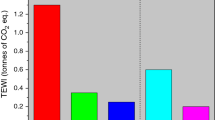Abstract
A vapor compression cycle (VCC) with integrated thermoelectric (TE) modules to boost the heating capacity of the system in an energy-efficient way, especially for cold climate operation, is suggested in this paper. While a baseline heat pump (HP) cycle absorbs heat from a source through an evaporator, the proposed system utilizes TE modules as an intermediate (or third) stage of an otherwise two-stage vapor compression system with a vapor injection compressor. This increases the overall system efficiency and augments the system capacity through the high coefficient of performance (COP) of the TE for small temperature lift conditions. To demonstrate the concept, a prototype refrigerant-to-solid (TE) heat exchanger, consisting of TE modules and microchannel flat tubes, was designed and fabricated so that the whole system could realize an additional 1 kW of heating capacity compared with the baseline system. The TE heat exchanger was integrated into a residential HP unit that uses R-410A as a refrigerant, and the system was tested in a laboratory under the severe condition of −17.8°C, in order to investigate the capacity improvement and the overall COP. Finally, an application of this technique in an automotive heating, ventilating, and air-conditioning system with HFC134a working fluid has been studied for the purpose of providing supplemental heating for electric vehicles and hybrid electric vehicles by establishing a detailed simulation model of a HP system with the TE heat exchanger. Both the laboratory test and the calculation study show that a VCC with integrated TE modules has both reasonable efficiency and increased heating capacity.
Similar content being viewed by others
Abbreviations
- COP:
-
Coefficient of performance
- EV:
-
Electric vehicle
- FCEV:
-
Fuel cell electric vehicle
- GI:
-
Gas injection
- h :
-
Enthalpy (kJ/kg)
- HP:
-
Heat pump
- HEV:
-
Hybrid electric vehicle
- HVAC:
-
Heating, ventilating, and air-conditioning
- ICE:
-
Internal combustion engine
- L :
-
Work input (kW)
- \( \dot{m} \) :
-
Mass flow rate (kg/s)
- MAC:
-
Mobile air-conditioning
- PHEV:
-
Plug-in hybrid electric vehicle
- PTC:
-
Positive temperature coefficient
- Q :
-
Heat flow (kW)
- RH:
-
Relative humidity (%)
- TE:
-
Thermoelectric
- TEHX:
-
Thermoelectric heat exchanger
- TIM:
-
Thermal interface material
- T :
-
Temperature
- VCC:
-
Vapor compression cycle
- ZT :
-
A figure of merit of thermoelectric material (–)
- C:
-
Condenser
- E:
-
Evaporator
- Comp:
-
Compressor
- GI:
-
Gas injection
- Hot:
-
Hot side of TE module
- Cold:
-
Cold side of TE module
- TE:
-
Thermoelectric
- GITE:
-
Gas injection integrated with thermoelectric
- DB:
-
Dry bulb
- WB:
-
Wet bulb
- FT:
-
Flash tank
- V:
-
Vapor
- L:
-
Liquid
- S:
-
Saturated state of a refrigerant
- Eva:
-
Evaporator
References
K. Inui, SAE Automotive Alternate Refrigerant Systems Symposium (2002), http://www.sae.org/events/aars/presentations/. Accessed 17 July 2011.
U. Hesse, SAE Automotive Alternate Refrigerant Systems Symposium (2002), http://www.sae.org/events/aars/presentations/. Accessed 17 July 2011.
M. Iguchi, T. Takahashi, K. Nakamura, T. Maruyama, and J. Hara, SAE Automotive Alternate Refrigerant Systems Sym- posium (2003), http://www.sae.org/events/aars/presentations/. Accessed 17 July 2011.
L.E. Bell, 1st Thermoelectrics IAV Conference (23–24 Oct. 2008, Berlin).
D. Wang, D. Crane, and J. LaGrandeur, Design and Analysis of a Thermoelectric HVAC System for Passenger Vehicles. SAE paper 2010-01-087.
B. Yang, H. Ahuja, and T.N. Tran, HVAC&R Res. 14, 635 (2008).
J. Schoenfeld, J. Muehlbauer, Y. Hwang, and R. Radermacher, International Refrigeration and Air Conditioning Conference at Purdue. Paper #2229 (July 14–17, 2008).
Handbook for Electric Vehicle (Maruzen Publishing Japan, March 2001).
N. Miyajima, K. Shikata, Y. Uemura, G. Uchida, and Y. Kato, Denso Tech. Rev. 4, 30 (1999).
X. Wang (Doctor of philosophy thesis, University of Maryland College Park, 2008).
Marlow Industries, Thermoelectric Cooling Systems Design Guide, http://www.marlow.com/media/marlow/images/(Lit)Downloads/design_guide.pdf. Accessed 17 July 2011.
H.Y. Zhang, Int. J. Refrig. 33, 1187 (2010).
TE Technology, Inc., http://www.tetech.com/Peltier-Thermoelectric-Cooler-Modules/High-Performance.html/. Accessed 17 July 2011.
S. Narumanchi, M. Mihalic, and K. Kelly, Thermal Interface Materials for Power Electronics Applications. NREL CP-540-42972 (July 2008).
Lennox, http://www.lennox.com/pdfs/brochures/Lennox_XP15_Heat_Pump.pdf/. Accessed 17 July 2011.
Copeland Scroll, http://www.digitalscroll.com/sb300/portal/home/normal/42/show/0/2/. Accessed 17 July 2011.
ASHRAE Standard, Methods of Testing for Rating Seasonal Efficiency of Unitary Air Conditioners and Heat Pumps, ANSI/ASHRAE 116-1995 (1995).
Author information
Authors and Affiliations
Corresponding author
Rights and permissions
About this article
Cite this article
Okuma, T., Radermacher, R. & Hwang, Y. A Novel Application of Thermoelectric Modules in an HVAC System Under Cold Climate Operation. J. Electron. Mater. 41, 1749–1758 (2012). https://doi.org/10.1007/s11664-012-2066-x
Received:
Accepted:
Published:
Issue Date:
DOI: https://doi.org/10.1007/s11664-012-2066-x



